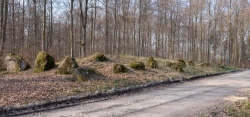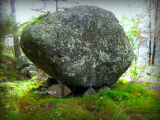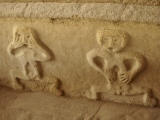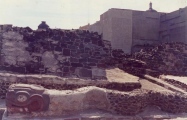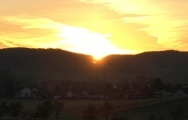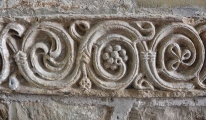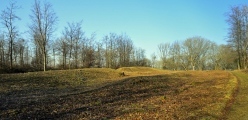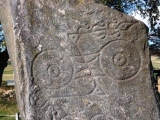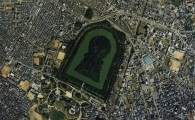Andy Burnham's Blog, page 237
April 9, 2019
Stubberup Skov Junkershøj Langdysse
Langdysse (Long Barrow) in Præstø, Denmark. The long barrow is 50m long by 8 metres wide and 1 metre high currently. In the middle are two chambers. In the southern chamber, one of the capstones is visible.
Published on April 09, 2019 06:02
April 5, 2019
Seid island Burnev
This type of rock formation is known as a propped boulder. They are often described as a natural feature placed by glaciation, but the theory of them being deliberately placed by man also has its supporters. This particular stone is in the St Petersburg area of Russia
Published on April 05, 2019 11:11
March 29, 2019
Vichama
Rare reliefs depict life and death at 3800 year old Peruvean site.. Ancient Settlement in Lima Region, Peru. A coastal town of the Chico Norte or Caral-Supe culture. It was roughly contemporary to Caral but the major building episodes are later than those at Caral. Described as a farming and fishing town.
Published on March 29, 2019 21:06
March 26, 2019
Tenochtitlan - Templo Mayor
Aztec war sacrifices found in Mexico may point to elusive royal tomb - more details in the comments on our page. Ancient Temple in Mexico City. When the Spanish conquistadors under Cortez conquered the capitol city of the Aztecs, Tenochtitlan, in 1519 this temple pyramid was the centre of the great city. Three years later the conquerors, under Cortez, began to raze the city and topple the twin temples found at the peak of Templo Mayor.
Published on March 26, 2019 10:46
Wersau Menhir
Standing Stone (Menhir) in Hesse. Top photo taken at the equinox - March 21st 2019 at 6:40 AM. The photo was taken from the location where the Menhir was found.
Published on March 26, 2019 05:12
Bruniquel Cave
At the 11ème Festival International du Film d'Archéologie de Nyon (26-30 March), archaeological news will be in the spotlight with the presentation of the film "Le mystère de la grotte de Bruniquel". This documentary presents the recent research that allowed the dating of a structure made by neanderthal man in a cave 175 000 years ago: it would therefore be the oldest human construction known to this day.. A Neanderthal structure made of broken stalagmites found 336 metres into this cave has now been discovered to be 175,000 years old. The extraordinary constructions are made from nearly 400 stalagmites that have been yanked from the ground and stacked on top of one another to produce rudimentary walls on the damp cave floor.
Published on March 26, 2019 02:46
March 22, 2019
St Mary and St Hardulf (Breedon on the Hill)
An Anglo Saxon cross shaft, and many other contemporary fragments at St Mary and St Hardulf's, Breedon on the Hill, Leicestershire. Whilst the church as it exists today is largely 13th century, it incorporates remains of the Medieval Priory Church of Breedon Priory and many 8th and 10th century Saxon sculptured stones.
Published on March 22, 2019 16:36
Heyshott Down Cross Dyke
The South Downs Way (aka. South Downs National Trail) runs through the centre of these Cross Dyke earthworks on the Cocking to Bignor Hill section in West Sussex. The four cross-dykes are thought to be late Bronze Age in date.
Published on March 22, 2019 05:46
March 18, 2019
Northern Earth March 2019 is Out Now
Here's what's in the latest issue of Northern Earth, out now:
Picturing the Picts - Recent researches into the dating and meaning of the enigmatic symbol stones
Controversies in the Halls of Heritage- Dodgy doings and developers
The Twelve Battles of Arthur - Everybody wants their bit of the Once and Future King.
Dave Weldrake reviews claims for the kings twelve
legendary battles
More...
Picturing the Picts - Recent researches into the dating and meaning of the enigmatic symbol stones
Controversies in the Halls of Heritage- Dodgy doings and developers
The Twelve Battles of Arthur - Everybody wants their bit of the Once and Future King.
Dave Weldrake reviews claims for the kings twelve
legendary battles
More...
Published on March 18, 2019 09:45
Book Review: Burial Mounds in Europe and Japan
This book is based on papers presented at an international workshop at Eberhard-Karls-University in association with the Sainsbury Institute for the Study of Japanese Arts & Cultures, and Osaka University, held in 2015.
The editors include an introduction which summarizes the history of research into burial mounds in Germany and that of in Japan, emphasizing the significance of comparative archaeology.
The editors include an introduction which summarizes the history of research into burial mounds in Germany and that of in Japan, emphasizing the significance of comparative archaeology.
Published on March 18, 2019 09:38

